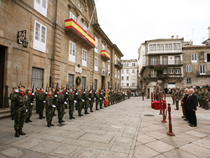- Home
- UNITS
- A Coruña
- Texto no traducido
- Find us
- Headquarters
MENÚ UNIDAD
ARMY UNITS
- Araba Álava |
- Albacete |
- Alicante |
- Almería |
- Asturias |
- Ávila |
- Badajoz |
- Barcelona |
- Burgos |
- Cáceres |
- Cádiz |
- Cantabria |
- Castellón |
- Ceuta |
- Ciudad Real |
- Córdoba |
- A Coruña |
- Cuenca |
- Girona |
- Granada |
- Guadalajara |
- Gipuzkoa |
- Huelva |
- Huesca |
- Islas Baleares |
- Jaén |
- León |
- Lleida |
- Lugo |
- Madrid |
- Málaga |
- Melilla |
- Murcia |
- Navarra |
- Ourense |
- Palencia |
- Las Palmas |
- Pontevedra |
- La Rioja |
- Salamanca |
- Segovia |
- Sevilla |
- Soria |
- Tarragona |
- Santa Cruz de Tenerife |
- Teruel |
- Toledo |
- Valencia |
- Valladolid |
- Bizkaia |
- Zamora |
- Zaragoza

Find us
HEADQUARTERS

 The Operational Logistic Force has its headquarters in the cities of A Coruña and Valencia. In A Coruña, the FLO headquarters Staff and the Communications Office are situated at the Palace of "Capitanía General". Those of the Support Unit to the headquarters, the tracking centre of logistic activity, the section of economic affairs and the legal consultancy are situated at the Atocha base. The Logistic Support Command for Operations can be found in the San Juan de Ribera barracks in Valencia.
The Operational Logistic Force has its headquarters in the cities of A Coruña and Valencia. In A Coruña, the FLO headquarters Staff and the Communications Office are situated at the Palace of "Capitanía General". Those of the Support Unit to the headquarters, the tracking centre of logistic activity, the section of economic affairs and the legal consultancy are situated at the Atocha base. The Logistic Support Command for Operations can be found in the San Juan de Ribera barracks in Valencia.
The Palace of "Capitanía General" is a neoclassical building from the eighteenth century by the engineer Juan Vergel. It is set in granite stonework, with a rectangular floor plan and a square central patio with arcades. It has three floors, the top floor with balconies and with a semicircular tympanum which has the coat of arms of the Crown engraved in stone and a clock. (How to get there)
The Atocha base, the former Infantry Headquarters “Principe Alfonso” is situated near Maria Pita square. It is a building with a neoclassical style façade, horizontal in design with a stone plinth on which enormous pilasters sit, with white washed walls and attics at the top.(How to get there)
The San Juan de la Ribera barracks in Valencia, occupy the site of the former convent bearing the same name and covers two large blocks separated by Serrano Flores Street. This notably fine building was built between the years 1870 and 1880 and looks out on to the pathway and its magnificent indoor patio.



